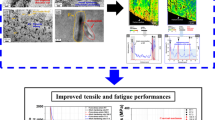Abstract
Pulse shaping techniques are an integral component of designing and executing valid Split-hopkinson pressure bar (SHPB) experiments. Proper pulse shaping is vital for achieving stress equilibrium and a constant strain rate within the dynamically tested sample. A systematic method based on two-dimensional finite element (FE) analysis was developed to design an optimized single material pulse shaper for SHPB testing of two stainless steel alloys. The tested alloys exhibit high strain-hardening, but have significantly different mechanical properties: Lean Duplex Stainless Steel 2101 (LDSS 2101) and austenitic stainless steel 316L. Results show that pulse shapers made of LDSS 2101 are capable of satisfying stress equilibrium and constant strain rate conditions for the studied materials at different strain rates regimes. The outlined FE analysis workflow is an effective approach to define the optimal dimensions of pulse shapers without the need for costly pulse-shaper-development experimental trials.












Similar content being viewed by others
References
Ameri AAH, Escobedo-Diaz JP, Quadir MZ et al (2018) Strain rate effects on the mechanical response of duplex stainless steel. In: AIP conference proceedings, vol 1979, p 070001. https://doi.org/10.1063/1.5044810
Lee W-S, Lin C-F, Chen T-H, Luo W-Z (2012) High temperature deformation and fracture behaviour of 316L stainless steel under high strain rate loading. J Nucl Mater 420:226–234. https://doi.org/10.1016/j.jnucmat.2011.10.005
Liu Y, Yan H, Wang X, Yan M (2013) Effect of hot deformation mode on the microstructure evolution of lean duplex stainless steel 2101. Mater Sci Eng A 575:41–47. https://doi.org/10.1016/j.msea.2013.03.036
Cheng M, Li C, Tang MX et al (2018) Intragranular void formation in shock-spalled tantalum: mechanisms and governing factors. Acta Mater 148:38–48. https://doi.org/10.1016/j.actamat.2018.01.029
Talonen J, Nenonen P, Pape G, Hanninen H (2005) Effect of strain rate on the strain-induced martensite transformation and mechanical properties of austenitic stainless steels. Metall Mater Trans A 36A:421–432
Gray G (2000) Classic split-hopkinson pressure bar testing. Mater Park OH ASM Int 2000 8:462–476. https://doi.org/10.1361/asmhba0003296
Gama B, Lopatnikov SL, Gillespie JW (2004) Hopkinson bar experimental technique: a critical review. Appl Mech Rev 57:223. https://doi.org/10.1115/1.1704626
Meyers MA (1994) Dynamic behavior of materials. Wiley, New York
Ramesh KT (2008) High strain rate and impact experiment. In: Handbook of experimental solid mechanics. Springer, New York, pp 929–960
Bodelot L, Escobedo-Diaz JP, Trujillo CP et al (2015) Microstructural changes and in-situ observation of localization in OFHC copper under dynamic loading. Int J Plast 74:58–74. https://doi.org/10.1016/j.ijplas.2015.06.002
Vecchio KS, Jiang F (2007) Improved pulse shaping to achieve constant strain rate and stress equilibrium in split-Hopkinson pressure bar testing. Metall Mater Trans A Phys Metall Mater Sci 38 A:2655–2665. https://doi.org/10.1007/s11661-007-9204-8
Naghdabadi R, Ashrafi MJ, Arghavani J (2012) Experimental and numerical investigation of pulse-shaped split Hopkinson pressure bar test. Mater Sci Eng A 539:285–293. https://doi.org/10.1016/j.msea.2012.01.095
Ellwood S, Griffiths LJ, Parry DJ (1982) Materials testing at high constant strain rates. J Phys E 15:280. https://doi.org/10.1088/0022-3735/15/3/009
Nemat-nasser S, Choi JY, Guo W, Isaacs JB (2005) High strain-rate, small strain response of a NiTi shape-memory alloy. J Eng Mater Technol 127:83–89. https://doi.org/10.1115/1.1839215
Frew DJ, Forrestal MJ, Chen W (2002) Pulse shaping techniques for testing brittle materials with a split Hopkinson pressure bar. Exp Mech 42:93–106. https://doi.org/10.1007/BF02428192
Nemat-Nasser S, Choi JY, Guo WG, Isaacs JB (2005) Very high strain-rate response of a NiTi shape-memory alloy. Mech Mater 37:287–298. https://doi.org/10.1016/j.mechmat.2004.03.007
Baranowski P, Malachowski J, Gieleta R, Damaziak K (2013) Numerical study for determination of pulse shaping design variables in SHPB apparatus. 61:459–466. https://doi.org/10.2478/bpasts-2013-0045
Frew DJ, Forrestal MJ, Chen W (2005) Pulse shaping techniques for testing elastic-plastic materials with a split hopkinson pressure bar. Exp Mech 45:186–195. https://doi.org/10.1177/0014485105052111
Cloete TJ, Paul G, Ismail EB (2014) Hopkinson bar techniques for the intermediate strain rate testing of bovine cortical bone subject areas. Philos Trans R Soc A 372:20130210. https://doi.org/10.1098/rsta.2013.0210
Zhou Z, Li X, Liu A, Zou Y (2011) International Journal of Rock Mechanics & Mining Sciences Stress uniformity of split Hopkinson pressure bar under half-sine wave loads. Int J Rock Mech Min Sci 48:697–701. https://doi.org/10.1016/j.ijrmms.2010.09.006
Chen W, Song B (2011) Split Hopkinson (Kolsky) bar design, testing and applications. Springer, New York
Song B, Chen W, Antoun BR, Frew DJ (2007) Determination of early flow stress for ductile specimens at high strain rates by using a SHPB. Exp Mech 47:671–679. https://doi.org/10.1007/s11340-007-9048-6
Song B, Connelly K, Korellis J et al (2009) Improved Kolsky-bar design for mechanical characterization of materials at high strain rates. Meas Sci Technol 20:115701. https://doi.org/10.1088/0957-0233/20/11/115701
Ameri AAH, Elewa NN, Ashraf M, Escobedo-Diaz JP (2017) General methodology to estimate the dislocation density from microhardness measurements. Mater Charact 131:324–330. https://doi.org/10.1016/j.matchar.2017.06.031
(2012) ANSYS mechanical APDL advanced analysis guide. Canonsburg, Technology Drive
LS-DYNA L (2007) Keyword user’ S manual
Zhao Z (1991) Shape design sensitivity analysis and optimization using the boundary element method. Springer, Berlin
Johnson G, Cook WH (1983) A constitutive model and data for metals subjected to large strains, high strain rates and high temperatures. In: The 7th international symposium on ballistics. pp 541–547
Samantaray D, Mandal S, Bhaduri AK (2009) A comparative study on Johnson Cook, modified Zerilli-Armstrong and Arrhenius-type constitutive models to predict elevated temperature flow behaviour in modified 9Cr-1Mo steel. Comput Mater Sci 47:568–576. https://doi.org/10.1016/j.commatsci.2009.09.025
Ravichandran G, Subhash G (1994) Critical appraisal of limiting strain rates for compression testing of ceramics in a split hopkinson pressure bar. J Am Ceram Soc 77:263–267
Baker WE (1996) A split hopkinson bar technique to evaluate the performance of accelerometers. J Appl Mech 63:353–356. https://doi.org/10.1115/1.2788872
Acknowledgements
Authors would like to thank Mr. Shameem Ahmed at the School of Engineering and Information Technology, UNSW Canberra for providing austenitic stainless steel material 316L. The authors would also like to acknowledge support by the Air Force Office of Scientific Research under Grant No. FA2386-17-1-4095.
Author information
Authors and Affiliations
Corresponding author
Rights and permissions
About this article
Cite this article
Ameri, A.A.H., Brown, A.D., Ashraf, M. et al. An Effective Pulse-Shaping Technique for Testing Stainless Steel Alloys in a Split-Hopkinson Pressure Bar. J. dynamic behavior mater. 5, 39–50 (2019). https://doi.org/10.1007/s40870-019-00181-3
Received:
Accepted:
Published:
Issue Date:
DOI: https://doi.org/10.1007/s40870-019-00181-3




